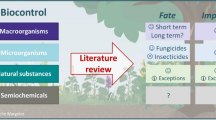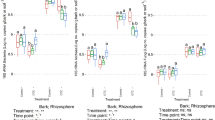Abstract
Four macrofungi species with ecological relationship to birch (Betula sp.) were analyzed with regard to the content of 21 detrimental and essential elements in their fruiting bodies. Two of the species (Leccinum scabrum and Leccinum versipelle) were mycorrhizal forming edible fruiting bodies while the others (Fomitopsis betulina and Inonotus obliquus) parasitic used in alternative medicine. The samples were collected near the town of Vimperk in the Bohemian Forest, the Czech Republic. L. scabrum accumulated Ag, Rb, Cd, Cs, Se, Cu, and Zn with bioconcentration factors of 22, 5.5, 4.7, 3.2, 2.0, 1.7, and 1.4, respectively. Similar trend in bioconcentration was revealed for L. versipelle with bioconcentration factors of 28, 5.2, 2.4, 1.9, 1.6, and 1.6 determined for Ag, Rb, Cu, Se, Zn, and Cd, respectively. Considerably high contents of Ca (400 ± 190 mg kg−1 dry matter), Fe (110 ± 30), Mg (1100 ± 300), and Zn (220 ± 90) were found in F. betulina. Similarly, high contents of Ca (1000 ± 700 mg kg−1 dry matter), Fe (110 ± 30), Mg (2000 ± 1100), Mn (410 ± 270), Rb (160 ± 60), and Zn (140 ± 70) were determined for I. obliquus. The different lifestyles (mycorrhizal vs. parasitic) were reflected in 13 significant differences of element contents.




Similar content being viewed by others

References
Borovička J, Braeuer S, Sácký J, Kameník J, Goessler W, Trubač J, Strnad L, Rohovec J, Leonhardt T, Kotrba P (2019) Speciation analysis of elements accumulated in Cystoderma carcharias from clean and smelter-polluted sites. Sci Total Environ 648:1570–1581. https://doi.org/10.1016/j.scitotenv.2018.08.202
Borovička J, Kotrba P, Gryndler M, Mihaljevič M, Řanda Z, Rohovec J, Cajthaml T, Stijve T, Dunn CE (2010) Bioaccumulation of silver in ectomycorrhizal and saprobic macrofungi from pristine and polluted areas. Sci Total Environ 408:2733–2744. https://doi.org/10.1016/j.scitotenv.2010.02.031
Brzezicha-Cirocka J, Grembecka M, Grochowska I, Falandysz J, Szefer P (2019) Elemental composition of selected species of mushrooms based on a chemometric evaluation. Ecotox Environ Safe 173:353–365. https://doi.org/10.1016/j.ecoenv.2019.02.036
Brzezicha-Cirocka J, Mędyk M, Falandysz J, Szefer P (2016) Bio- and toxic elements in edible wild mushrooms from two regions of potentially different environmental conditions in eastern Poland. Environ Sci Pollut Res 23:21517–21522. https://doi.org/10.1007/s11356-016-7371-0
Chen H, Fu L, Dong P, Zhang X, Lu X (2009) Acute toxicity evaluation and compositional analysis of a polysaccharide from the medicinal mushroom Inonotus obliquus. In: Proceedings, 3rd international conference on bioinformatics and biomedical engineering, Beijing 4541-4544
Falandysz J (2018) Mineral constituents in Leccinum scabrum from lowland locations in the central Europe and their relation to concentration in forest topsoil. J Environ Sci Health B 53:546–560. https://doi.org/10.1080/03601234.2018.1462914
Falandysz J, Borovička J (2013) Macro and trace mineral constituents and radionuclides in mushrooms: health benefits and risks. Appl Microbiol Biotechnol 97:477–501. https://doi.org/10.1007/s00253-012-4552-8
Falandysz J, Kunito T, Kubota R, Bielawski L, Mazur A, Falandysz JJ, Tanabe S (2007) Selected elements in Brown Birch Scaber Stalk Leccinum Scabrum. J Environ Sci Heal A 42:2081–2088. https://doi.org/10.1080/10934520701626993
Falandysz J, Treu R, Meloni D (2021) Distribution and bioconcentration of some elements in the edible mushroom Leccinum Scabrum from locations in Poland. J Environ Sci Heal B 56 https://doi.org/10.1080/03601234.2021.1892433
García MÁ, Alonso J, Melgar MJ (2009) Lead in edible mushrooms Levels and bioaccumulation factors. J Hazard Mater 167:777–783. https://doi.org/10.1016/j.jhazmat.2009.01.058
Gil YG, Kang S, Chae A, Kim YK, Min DH, Jang H (2018) Synthesis of porous Pd nanoparticles by therapeutic chaga extract for highly efficient tri-modal cancer treatment. Nanoscale 10:19810–19817. https://doi.org/10.1039/c8nr07172a
Javed S, Mitchell K, Sidsworth D, Sellers SL, Reutens-Hernandez J, Massicotte HB, Egger KN, Lee CH, Payne GW (2019) Inonotus obliquus attenuates histamine-induced microvascular inflammation. PLoS One 14:1–16. https://doi.org/10.1371/journal.pone.0220776
Kalač P (2019) Mineral composition and radioactivity of edible mushrooms. Elsevier, Academic Press, London
Krasińska G, Falandysz J (2016) Mercury in Orange Birch Bolete Leccinum versipelle and soil substratum: bioconcentration by mushroom and probable dietary intake by consumers. Environ Sci Pollut Res 23:860–869. https://doi.org/10.1007/s11356-015-5331-8
Mędyk M, Grembecka M, Brzezicha-Cirocka J, Falandysz J (2017) Bio- and toxic elements in mushrooms from the city of Umea and outskirts, Sweden. J Environ Sci Health B 52:577–583. https://doi.org/10.1080/03601234.2017.1318638
Mędyk M, Loganathan B, Bielawski L, Falandysz J (2018) Inorganic elemental concentrations in birch bolete mushroom (Leccinum scabrum) and top soil: contamination profiles, bioconcentration and annual variations. J Environ Sci Health B 53:831–839. https://doi.org/10.1080/03601234.2018.1505087
Mleczek M, Niedzielski P, Kalač P, Budka A, Siwulski M, Gąsecka M, Rzymski P, Magdziak Z, Sobieralski K (2016) Multielemental analysis of 20 mushroom species growing near a heavily trafficked road in Poland. Environ Sci Pollut Res 23:16280–16295. https://doi.org/10.1007/s11356-016-6760-8
Mleczek M, Siwulski M, Mikołajczak P, Gąsecka M, Rissmann I, Goliński P, Sobieralski K (2015a) Differences in Cu content in selected mushroom species growing in the same unpolluted areas in Poland. J Environ Sci Health B 50:659–666. https://doi.org/10.1080/03601234.2015.1038959
Mleczek M, Siwulski M, Mikołajczak P, Goliński P, Gąsecka M, Sobieralski K, Dawidowicz L, Szymańczyk M (2015b) Bioaccumulation of elements in three selected mushroom species from southwest Poland. J Environ Sci Health B 50:207–216. https://doi.org/10.1080/03601234.2015.982427
Mleczek M, Siwulski M, Stuper-Szablewska K, Rissmann I, Sobieralski K, Goliński P (2013) Accumulation of elements by edible mushroom species: Part I. Problem of trace element toxicity in mushrooms. J Environ Sci Health B 48:69–81. https://doi.org/10.1080/03601234.2012.716733
Petkovšek SAS, Pokorny B (2013) Lead and cadmium in mushrooms from the vicinity of two large emission sources in Slovenia. Sci Total Environ 443:944–954. https://doi.org/10.1016/j.scitotenv.2012.11.007
Šíma J, Vondruška J, Svoboda L, Šeda M, Rokos L (2019) The accumulation of risk and essential elements in edible mushrooms Chlorophyllum rhacodes, Suillus grevillei, Imleria badia, and Xerocomellus chrysenteron growing in the Czech Republic. Chem Biodivers 16:1–11. https://doi.org/10.1002/cbdv.201800478
Szymański M, Smolibowska J, Szymański A (2019) An investigation into the relationships between antioxidant activity and chemical elements as well as polyphenolics in fungal fruiting bodies growing on Betula L. J Elem 24:193–205. https://doi.org/10.5601/jelem.2018.23.2.1412
Zhang D, Zhang Y, Morawska E, Bielawski L, Krasińska G, Drewnowska M, Pankavec S, Szymańska K, Falandysz J (2013) Trace elements in Leccinum scabrum mushrooms and topsoils from Kłodzka Dale in Sudety Mountains, Poland. J Mt Sci 10:621–627. https://doi.org/10.1007/s11629-013-2384-3
Zhang Y, Zhao Y, Cui H, Cao C, Guo J, Liu S (2011) Comparison of hypoglycemic activity of fermented mushroom of Inonotus obliquus rich in vanadium and wild-growing I. obliquus. Biol Trace Elem Res 144:1351–1357. https://doi.org/10.1007/s12011-011-9043-8
Acknowledgements
The authors are much obliged to Prof. Pavel Kalač for many helpful comments.
Availability of data and materials
The datasets (material) used and analyzed during the current study are available from the corresponding author on reasonable request.
Funding
No external source of funding for the research was available. The research was financed by University of South Bohemia, Faculty of Agriculture.
Author information
Authors and Affiliations
Contributions
JK collected the mushroom samples, performed the experiments, and analyzed the data. JŠ analyzed the data and wrote the article. MK performed the complete statistical analysis. MŠ performed the experiments and analyzed the data. LS performed the experiments and supervised the biological aspects of the study.
Corresponding author
Ethics declarations
Ethics approval
Not applicable. The manuscript does not report on or involve the use of any animal or human data or tissue.
Consent to participate
Not applicable. The manuscript does not report on or involve the use of any animal or human data or tissue.
Consent for publication
Not applicable. The manuscript does not contain data from any individual person.
Competing interests
The authors declare no competing interests.
Additional information
Responsible Editor: Philippe Garrigues
Publisher’s note
Springer Nature remains neutral with regard to jurisdictional claims in published maps and institutional affiliations.
Rights and permissions
About this article
Cite this article
Krejsa, ., Šíma, J., Kobera, M. et al. Detrimental and essential elements in fruiting bodies of mushrooms with ecological relationship to birch (Betula sp.) collected in the Bohemian Forest, the Czech Republic. Environ Sci Pollut Res 28, 67852–67862 (2021). https://doi.org/10.1007/s11356-021-13762-4
Received:
Accepted:
Published:
Issue Date:
DOI: https://doi.org/10.1007/s11356-021-13762-4



